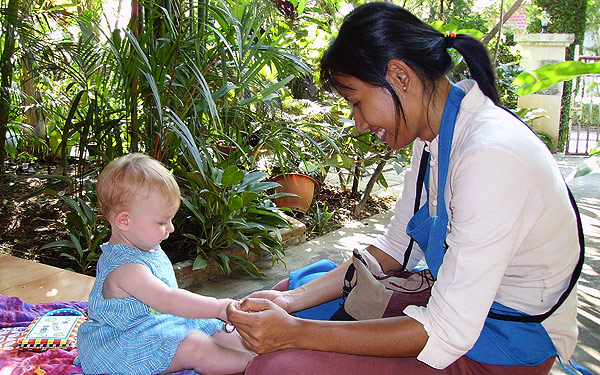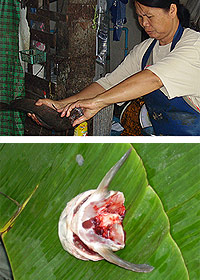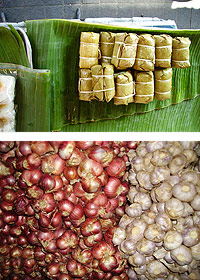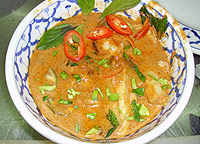
And this right here is your chili line. You will eat many chilis in your life.
|
|
So Sarah’s all, “Let’s take cooking classes while we’re in Thailand,” and I must have agreed, because now we’re shopping for ingredients in a Chiang Mai food market with a chef and a gaggle of Australians, Norwegians, Welsh, and Swiss. The highlight of the tour was watching a dour woman bludgeon a live fish to death with two vicious blows to the head. Later, I saw her rip the head off another victim so suddenly and definitively that its heart continued to beat in its dismembered torso. She was like Hannibal Lecter, if Lecter had targeted fish. And was an old Thai woman.
While the rest of the stunned westerners—including my fascinated 11-month-old baby—gaped at this murder with me, I noticed the woman rubbing blood on the fish’s skin.
“Why is she doing that?” I whispered.
“To make the fish look fresh, I think,” Sarah said.
Mmmmm, let’s go cook some pad Thai!
|
|
We were taken by van to a luxurious house on the outskirts of Chiang Mai. It was owned by Sompon Nabnian, “Thailand international TV chef” who hosts classes out his home, a tropical Shangri-la outfitted with an impressive expo kitchen—mirrors and all—and an open-air garden space with dozens of cooking stations and woks so that his charges can mangle his steamed banana cake recipes amidst palm trees. The more ambitious foodies stay in an affiliated boutique hotel, the Jasmine Rice Village Boutique Resort & Spa nearby, surrounded by paddy fields of gently swaying rice, presumably to learn Nabnian’s untold secrets about papayas.
Thailand’s culinary heritage is famous, employing as it does famously spicy chilis, tons of sticky rice, and the ubiquitous nam pla, a.k.a. that fish sauce that smells skeezy but tastes wonderful. Lemongrass, lime, coconuts, coriander: the ingredients are interesting and plentiful and even I couldn’t screw them up. Nabnian and his staff teach us standards like tom kha kai (chicken in coconut milk soup) and fish in red curry. (I suspect these fish came from the Caligula of the market.) I followed the recipes robotically, and was able to make reasonable facsimiles of Thai food, though Nabnian himself told me I chopped my coriander too small, my shallots too big, and my noodles too long. “Burned your garlic too,” he said. “Otherwise, not bad.” Sarah’s, of course, were perfect.
|
|
And where was Hannah during all this? Sitting on a blanket on the floor. She basically spent five hours entertaining herself, which, if you don’t have an 11-month-old of your own, I should tell you, is a miracle along the lines of the U.S Olympic hockey team in 1980. When she wasn’t reading quietly or playing with various beeping toys, she was being entertained by Nabnian’s cooking school underlings, who seemed to have endless reservoirs of interest and patience.“ Thailand is like one great big babysitter,” Sarah said. Under the right circumstances, with the cooperation of the Thais, my daughter, and the mighty Sompon Nabnian, I’m certain I could master Thai cooking in about 25 years.





